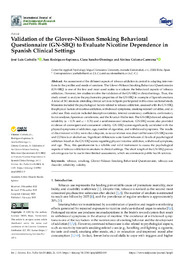Por favor, use este identificador para citar o enlazar este ítem:
https://hdl.handle.net/11000/33992Registro completo de metadatos
| Campo DC | Valor | Lengua/Idioma |
|---|---|---|
| dc.contributor.author | Carballo, José Luis | - |
| dc.contributor.author | Rodríguez-Espinosa, Sara | - |
| dc.contributor.author | Sancho-Domingo, Clara | - |
| dc.contributor.author | Coloma-Carmona, Ainhoa | - |
| dc.contributor.other | Departamentos de la UMH::Psicología de la Salud | es_ES |
| dc.date.accessioned | 2024-11-22T13:31:08Z | - |
| dc.date.available | 2024-11-22T13:31:08Z | - |
| dc.date.created | 2023-01-08 | - |
| dc.identifier.citation | International Journal of Environmental Research and Public Health, 2023, 20, 1119 | es_ES |
| dc.identifier.issn | 1660-4601 | - |
| dc.identifier.issn | 1661-7827 | - |
| dc.identifier.uri | https://hdl.handle.net/11000/33992 | - |
| dc.description.abstract | An assessment of the different aspects of tobacco addiction is central to adapting interventions to the profiles and needs of smokers. The Glover–Nilsson Smoking Behavioral Questionnaire (GN-SBQ) is one of the few and most used scales to evaluate the behavioral aspects of tobacco addiction. However, few studies involve the validation of the GN-SBQ in clinical settings. Thus, this study aimed to analyze the psychometric properties of the GN-SBQ in a sample of Spanish smokers. A total of 341 smokers attending clinical services in Spain participated in this cross-sectional study. Measures included the psychological factors related to tobacco addiction, assessed with the GN-SBQ, the physical factors of nicotine addiction, withdrawal symptoms, smoking-related variables, and alcohol use. Data analysis included descriptive statistics, internal consistency coefficients, confirmatory factor analyses, Spearman correlations, and the Kruskal–Wallis test. The GN-SBQ showed adequate reliability (α = 0.76 and ω = 0.76) and a unidimensional structure. GN-SBQ scores also provided evidence of convergent and concurrent validity. GN-SBQ scores significantly correlated with the physical symptoms of addiction, age, number of cigarettes, and withdrawal symptoms. The results of discriminant validity were also adequate, as no correlation was observed between GN-SBQ scores and CO levels or alcohol use. Significant differences were found between all levels of psychological addiction based on the GN-SBQ scores regarding physical nicotine addiction, withdrawal symptoms, and age. Thus, this questionnaire is a reliable and valid instrument to assess the psychological aspects of tobacco addiction in smokers in clinical settings. The short length of the GN-SBQ proves advantageous for its use in time-limited assessments, which are common in public health services. | es_ES |
| dc.format | application/pdf | es_ES |
| dc.format.extent | 14 | es_ES |
| dc.language.iso | eng | es_ES |
| dc.publisher | MDPI | es_ES |
| dc.rights | info:eu-repo/semantics/openAccess | es_ES |
| dc.rights | Attribution-NonCommercial-NoDerivatives 4.0 Internacional | * |
| dc.rights.uri | http://creativecommons.org/licenses/by-nc-nd/4.0/ | * |
| dc.subject | tobacco | es_ES |
| dc.subject | smoking | es_ES |
| dc.subject | Glover–Nilsson Smoking | es_ES |
| dc.subject | Behavioral Questionnaire | es_ES |
| dc.subject | tobacco use disorder | es_ES |
| dc.subject | reliability | es_ES |
| dc.subject | validity | es_ES |
| dc.subject.other | CDU::1 - Filosofía y psicología::159.9 - Psicología | es_ES |
| dc.title | Validation of the Glover–Nilsson Smoking Behavioral Questionnaire (GN-SBQ) to Evaluate Nicotine Dependence in Spanish Clinical Settings | es_ES |
| dc.type | info:eu-repo/semantics/article | es_ES |
| dc.relation.publisherversion | https://doi.org/10.3390/ijerph20021119 | es_ES |

Ver/Abrir:
2_Validation of the Glover-Nilsson Smoking Behavioral Questionnaire (GN-SBQ) to evaluate nicotine dependence in Spanish clinical settings.pdf
615,68 kB
Adobe PDF
Compartir:
 La licencia se describe como: Atribución-NonComercial-NoDerivada 4.0 Internacional.
La licencia se describe como: Atribución-NonComercial-NoDerivada 4.0 Internacional.
.png)